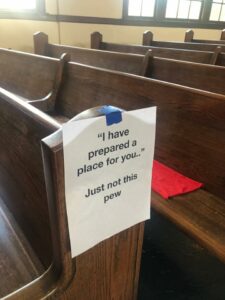In the post-COVID world, there are many things we would never have dreamed of doing in “the Before Times”, but that are necessary in the situation we find ourselves in now. Here are a few that I’ve encountered as we prepare to reopen the church for worship.

Reservations: With restrictions on how many people can safely occupy a single indoor space, we are going to be requiring reservations online or by phone for Sunday morning services, with a deadline of Friday at noon before the relevant Sunday (leaving 3-5 “slots” available for visitors who may drop in). This is a procedure completely counter to my approach to church for the entire rest of my life, which is “Worship is public! All are welcome! We want you to come!” (In fact, sometimes I’ve been fixated on church attendance numbers to the detriment of other aspects of ministry.) It’s jarring to even think of having to tell someone, “No, you can’t come to this church service even though you are willing and able to.” But for the time being at least, it’s necessary, to keep everyone safe.
Hymns: I’m generally very reluctant to abbreviate hymns; most hymns are actually written as a cohesive whole, so that cutting verses often reduces the text to incoherence, and I like belting out all the verses of favourite hymns. But in a couple of weeks, we will begin hybrid worship, with a congregation in the church in person but also significant numbers tuning in via Zoom from home. And the in-person congregation will be forbidden from singing, while for the Zoom congregation, singing along with the recorded music is one of the high points of the service. In order to try to thread the needle between these competing concerns, we will probably be incorporating at least one hymn where only one verse is sung, so that the Zoomites* can sing along at home while the folks in the church building only have to sit silent through a single verse.
The communion cup: Once we move to Phase III of reopening, which will permit us to celebrate the Eucharist, the diocesan guidelines stipulate that only the celebrant will receive the wine. This goes against every conviction I have about clericalism and the sacrament; if only one person must consume the wine, I would strongly prefer that it be someone other than myself. But those are not the instructions we have been given, and our priority now is to comply with the guidelines and keep everybody safe.
Baptisms: Long before I went to seminary, since childhood, I remember my mother, as a lay ministry professional, struggling to change the culture of baptism in our parish. She, and many others at the same time, wanted to impress upon people the importance of celebrating Christian initiation in the context of the Sunday morning Eucharist, not in a private family service, and of taking the baptismal vows seriously. Private baptisms have been limited to emergency situations since the BAS came out in the 1980s, and that limitation still technically applies. However, for the two baptisms that the parish is planning in September, the “public service” in which they are taking place will be not a Sunday morning service, but a Friday afternoon Messy Church, or a Saturday Evening Prayer, and the majority of the congregation will still be tuning in by Zoom. The families are understandably uncomfortable with bringing small children (and, in some cases, medically vulnerable adults) into a room filled to capacity, even COVID-era capacity, with strangers. This is an example of us employing the available technology to reinforce the bonds between members of the parish community when we cannot gather in person; if anything, the extraordinary circumstances invite us to reflect more deeply on what we are actually doing as we gather to bring new children of God into the body of Christ.
Kids in church: Before the pandemic struck, we had been blessed with extraordinary growth in young families with children attending services, and we were working on adjusting to the increased presence of small children’s sounds and wiggles in worship. As we consider returning, we must acknowledge that kids who are old enough to be mobile but too young to understand social distancing pose a risk of spreading infection. We are not going to ban kids from church. But until there is reliable rapid testing and/or a vaccine, we will have only a limited number of spaces for families with children between the ages of about 1 and 8, unless there is an adult who is willing to essentially maintain physical contact with the child throughout the service. There will be one spot in the loft and two in the chapel (separated by baby gates) so that the little ones can have space to move without being at risk of touching someone they shouldn’t.
These are temporary measures only, until we can relax our vigilance. Families with kids are not being banished to the loft for good, and when we are all able to share pews and the cup and pass the peace and hug again, we will have a giant party and dance together in the aisles, all ages from 1 to 101. We’ll sing our hearts out and pack the place to the rafters and rejoice in the incarnate life together that God intended for us. But in the meantime, there are a lot of things that we’re doing now, in order to love each other well and keep each other safe, that I never imagined I would ever be doing, when I was in seminary.
*new word coinage thanks to Bill Wilson
Leave a Reply